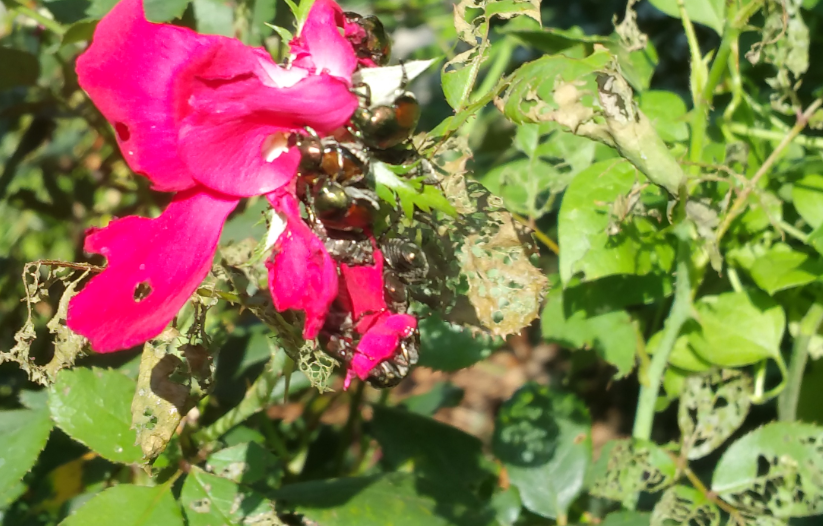I Ain’t Afraid of No Bug!

By Melanie Stewart
You’ve seen them lurking in the shrubs and working under leaves. They buzz you as you walk to your front door. They are the next generation of thieves, stealing your trees, your garden, and even your lawn. They are Japanese beetles, insects with metallic green bodies and copper-orange wings.
That sounds overdramatic, but it isn’t if you’ve noticed the damage on any of the 300 species they like to eat. You may have seen Linden/Boxwood trees turning brown from the top down, leaves eaten into lace. Rosebushes are some of their favorite snacks—they can decimate buds, plants, and gardens. You may start to notice damage to lawns, caused by the beetle’s larvae, and maybe moles that burrow into your yard to eat them. Not pretty!
While no pest is welcome in your garden or yard, the Japanese beetle is particularly bad this year. It has few natural enemies, and more larvae survived our warmer-than-usual winter. Unlike many insects, it lays eggs in your lawn daily for over a month, creating more larvae to damage your lawn and more beetles to feast upon your plants next year.
Your first instinct is probably to break out the pesticide and spray them into oblivion. Hold that thought. The only pesticides that work require special handling, also kill beneficial insects, and are unsafe for edible plants, pets, wildlife, and waterways.
So what can you do?
There are several environmentally friendly options.
Get rid of the adults.
- Pick them off and drop them into soapy water. If you want to feed them to the fish or chickens, use plain water, no soap. This works best in early morning.
- Don’t use traps, they will attract more bugs to your yard.
Control the grubs without hurting the beneficial insects you are working to attract:
- Apply parasitic nematodes (Heterorhabditis bacteriophora) to your lawn to eat the larvae. They are effective if properly watered in and the ground kept moist.
- Apply Bacillus thuringiensis to specifically kill grubs.
- Apply milky spore. Grubs eat it, die, and release more spores which infect more grubs. It takes 3-5 years to be effective, but provides a longer-term solution as it becomes established in the soil.
- Attract birds. Robins, bluebirds, and others will eat the grubs.
- Talk to your neighbors about using organic controls.
Adults are about ready to die off here, but controlling grubs now will make a difference next summer.
